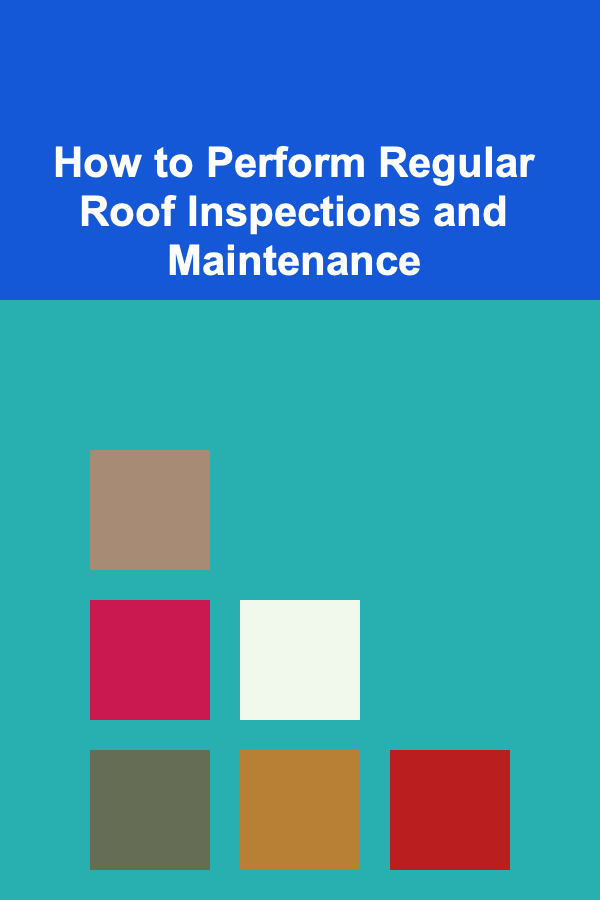
How to Perform Regular Roof Inspections and Maintenance
ebook include PDF & Audio bundle (Micro Guide)
$12.99$5.99
Limited Time Offer! Order within the next:

Your roof is one of the most vital components of your home. It protects you, your family, and everything inside from the elements, ensuring safety and comfort. Over time, however, wear and tear, extreme weather conditions, and other factors can take their toll on the roof, leading to issues like leaks, water damage, and structural problems. To keep your roof in optimal condition and prevent costly repairs or replacements, regular roof inspections and maintenance are essential. In this article, we will provide a comprehensive guide on how to perform roof inspections and maintain your roof effectively.
Why Regular Roof Inspections and Maintenance are Important
Roof maintenance is often overlooked because it's easy to forget about something that's out of sight. However, neglecting roof care can result in minor issues turning into significant, costly problems. Here are several reasons why regular roof inspections and maintenance are crucial:
1. Identify Problems Early
By conducting routine inspections, you can spot issues before they become severe. Early detection of leaks, damaged shingles, or other problems can prevent extensive damage to the roof structure and interior of the house.
2. Prolong the Lifespan of Your Roof
Roofs, depending on the material, can last anywhere from 15 to 50 years, but only if they are well-maintained. Regular inspections and maintenance help keep your roof in good condition for as long as possible, avoiding premature wear and reducing the need for a full replacement.
3. Avoid Expensive Repairs
Fixing minor issues is much cheaper than dealing with significant damage caused by undetected problems. For example, a small leak can quickly turn into a major water infiltration issue, leading to mold growth and rotting wood, both of which are expensive to repair.
4. Increase Property Value
A well-maintained roof contributes to your home's curb appeal and overall property value. Potential buyers will appreciate knowing that the roof has been regularly inspected and is in good condition, which can be a selling point.
5. Ensure Safety
A compromised roof can lead to structural issues that may pose a safety risk to the inhabitants. Regular inspections help ensure that the roof remains strong and safe, preventing the possibility of collapse or other dangerous situations.
When to Perform Roof Inspections
Ideally, you should inspect your roof at least twice a year---once in the spring and once in the fall. These seasons are ideal because they allow you to check for damage caused by harsh weather conditions such as winter storms or summer heat.
Additional Inspections After Severe Weather
You should also inspect your roof after any severe weather event such as a storm, hail, high winds, or heavy snowfall. These events can cause significant damage to roofing materials, so it's essential to check for any issues promptly.
How to Perform a Roof Inspection
Roof inspections can be broken down into several critical steps, focusing on various areas of the roof to ensure no issues are overlooked. While some aspects of the inspection can be done safely by homeowners, other tasks should be left to professionals, especially when working with steep or high roofs.
Step 1: Inspect the Roof from the Ground
Before getting onto the roof, it's a good idea to start by visually inspecting the roof from the ground. This initial survey can help you spot any obvious issues, such as missing shingles, sagging gutters, or debris buildup.
- Look for Visible Damage: Using binoculars, check for any obvious signs of damage like missing, cracked, or curling shingles. Pay attention to the ridge and peak of the roof, where damage can be harder to spot.
- Check for Debris: Take note of any fallen branches, leaves, or other debris that may have collected on the roof. Accumulated debris can trap moisture, leading to rot or mold growth.
- Inspect Gutters and Downspouts: Ensure that gutters and downspouts are clear of debris and functioning correctly. Clogged gutters can cause water to pool, leading to roof damage or water penetration into your home.
Step 2: Assess the Roof Shingles
Shingles are one of the most common components to be damaged over time, and they play a critical role in protecting your home from water infiltration. A thorough inspection of the shingles is essential.
- Check for Missing Shingles: Missing or displaced shingles are a red flag that needs immediate attention. If left unaddressed, exposed areas can lead to leaks.
- Inspect for Curling or Buckling: Shingles that are curling or buckling may be an indication that they are nearing the end of their lifespan or have been affected by weather conditions. This issue can compromise the roof's ability to protect against water infiltration.
- Look for Cracks or Granule Loss: Inspect shingles for any cracks or noticeable granule loss. Granules help protect shingles from UV rays and contribute to their longevity. Loss of granules can cause shingles to deteriorate prematurely.
Step 3: Examine Roof Flashing and Valleys
Flashing is the material used to seal roof joints and areas where the roof meets vertical surfaces such as chimneys, vents, or skylights. The roof valleys are the areas where two slopes meet, and they are highly susceptible to leaks.
- Check Flashing for Damage: Inspect the flashing around chimneys, vents, and skylights for signs of wear or damage. Look for cracks, rust, or loose sections, as these can lead to water penetration.
- Inspect Roof Valleys: Valleys should be free of debris, and the flashing in these areas should be intact to prevent water from leaking through. If the flashing is damaged, it may need to be repaired or replaced.
Step 4: Inspect Roof Ventilation and Insulation
Proper ventilation is essential to maintaining the health of your roof and the energy efficiency of your home. Poor ventilation can lead to overheating in the attic, which can cause shingles to deteriorate, while inadequate insulation can result in ice dams forming during the winter months.
- Check Roof Vents: Inspect the vents on your roof to ensure they are clear of debris and functioning correctly. Roof vents allow warm air to escape from the attic, preventing heat buildup.
- Inspect Attic Insulation: Inadequate attic insulation can lead to condensation, which can damage the roof structure and encourage mold growth. Make sure that your attic insulation is properly installed and does not obstruct the vents.
Step 5: Look for Signs of Water Damage
Water damage is one of the most common and destructive issues a roof can face. Checking for signs of water infiltration will help prevent severe problems like rot, mold, and structural damage.
- Examine the Interior Ceiling: Inside your home, inspect ceilings for stains, discoloration, or sagging, which may be signs of water damage from a leaky roof.
- Check for Mold or Mildew: Look for mold growth or a musty smell in the attic or upper levels of your home, as these can be indicators of hidden water leaks.
Step 6: Check the Roof Structure
In addition to inspecting the roof surface, it's also important to evaluate the underlying roof structure to ensure there are no issues that could affect the roof's integrity.
- Look for Sagging: If your roof appears to be sagging in certain areas, it could indicate structural damage or weakened support beams.
- Inspect for Rotting Wood: If you have access to the attic, check the rafters and decking for signs of rotting or water damage. Rotting wood is a serious issue that can compromise the roof's stability.
Roof Maintenance Tips
In addition to performing regular inspections, it's important to take proactive steps to maintain your roof and prevent damage. Here are some essential roof maintenance tips:
1. Clean Your Gutters Regularly
Clogged gutters can cause water to back up onto the roof, leading to leaks and water damage. Clean your gutters at least twice a year, or more frequently if you have overhanging trees that shed a lot of leaves. Consider installing gutter guards to help prevent debris buildup.
2. Trim Trees and Shrubs
Overhanging branches can damage shingles and allow debris to accumulate on the roof. Trim trees and shrubs regularly to prevent branches from scraping or breaking shingles.
3. Address Small Issues Promptly
If you notice any small issues during your inspections, take care of them right away before they escalate into bigger problems. Small leaks, loose shingles, and minor flashing issues are much easier and cheaper to repair when caught early.
4. Improve Roof Ventilation
Ensure that your attic has adequate ventilation to regulate temperature and moisture levels. Proper ventilation will help extend the lifespan of your roof and prevent issues like ice dams in the winter.
5. Ensure Proper Insulation
Proper insulation in the attic prevents heat from escaping and protects against ice dams. Make sure your attic is properly insulated and that the insulation is evenly distributed.
6. Schedule Professional Inspections
While DIY inspections are important, it's also a good idea to have a professional roof inspection every few years. A roofing contractor will be able to spot potential issues that may not be immediately visible to an untrained eye.
Conclusion
Regular roof inspections and maintenance are essential for preserving the longevity of your roof and preventing expensive repairs or replacements. By understanding how to inspect your roof properly and following a regular maintenance schedule, you can protect your home from water damage, structural issues, and other roofing problems. Always remember that when in doubt, it's better to call in a professional to ensure your roof remains in top condition. Regular care and attention will ensure that your roof continues to protect your home for many years to come.
Reading More From Our Other Websites
- [Home Renovating 101] How to Elevate Your Kitchen with the Latest Hardware Trends: A Guide to Knobs, Pulls, and More
- [Home Storage Solution 101] How to Master Pot and Pan Storage Solutions to Declutter Your Kitchen Cabinets
- [Personal Care Tips 101] How to Maintain Healthy Skin by Exfoliating with Body Scrubs Regularly
- [Hiking with Kids Tip 101] Lightweight Kids Hiking Backpacks for Adventurous Little Explorers
- [Personal Care Tips 101] How to Choose a Face Mask with Exfoliating Properties
- [Personal Investment 101] The Future of Passive Income: How Deep Learning Can Help
- [Organization Tip 101] Top Low VOC Paint Brands for a Healthier Home Renovation
- [Home Renovating 101] How to Market Your House Renovation Business Effectively
- [Horseback Riding Tip 101] Top & Saddle Materials Compared: Leather, Synthetic, and Hybrid Options Reviewed
- [Home Lighting 101] How to Install LED Lighting in Your Home on a Budget

How to Clean Your Bathroom in Under 15 Minutes
Read More
How to Plan a Budget for Staging Cost Per Room Without Overspending
Read More
How to Use Cashback and Rewards Programs Wisely
Read More
How to Utilize ChatGPT for Language Translation
Read More
Selecting the Best Loaf Pans for Homemade Breads: A Comprehensive Guide
Read More
10 Tips for Staying on Track with Your Retirement Savings Goals
Read MoreOther Products

How to Clean Your Bathroom in Under 15 Minutes
Read More
How to Plan a Budget for Staging Cost Per Room Without Overspending
Read More
How to Use Cashback and Rewards Programs Wisely
Read More
How to Utilize ChatGPT for Language Translation
Read More
Selecting the Best Loaf Pans for Homemade Breads: A Comprehensive Guide
Read More